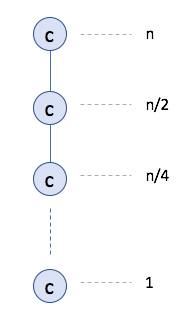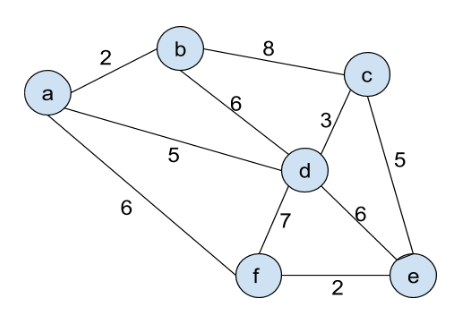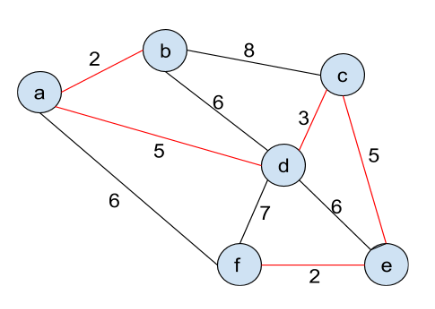Recitation 11
Recitation notes for the week of April 9, 2025.
HW 6, Question 1
A Clarification
For this problem, assume $0^0=1$.
Part (a)
This part is fairly straightforward so we'll keep it short and sweet:
Algorithm
We will literally multiply $a$ with itself $n$ times.
Algorithm Details
#Inputs: non-negative integers a and n
ans = 1
for i = 1 to n
ans *= a
return ans
Exercise
Argue that the above algorithm takes $O(n)$ time.
Part (b)
We start with an important reminder:
HW 6 Q1(b)
Make sure you present a recursive divide and conquer algorithm for part (b) on Q1 on HW 6 and and analyze it via a recurrence relation. Otherwise you will get a 0 on all parts.
Recurrence Relations
$T(n) = T(n/2)+O(1)$
We start off with the Binary search algorithm (stated as a divide and conquer algorithm):
Binary Search
// The inputs are in A[0], ..., A[n-1]; v
l = 0
r = n-1
return binary_search(A,l,r,v)
# Recursive definition of Binary Search
def binary_search(A,l,r,v):
if l == r:
return v == A[l] # Return 1 if A[l]=v and 0 otherwise
else:
m = (l-r)/2
if v <= A[m]:
return binary_search(A,l,m,v)
else:
return binary_search(A,m,r,v)
It is easy to check that every line except the recursive calls of binary_search takes $O(1)$ time. So if $T(n)$ is the runtime of binary_search, then it satisfies the following recurrence relation:
Recurrence Relation 1
\[T(n)\le \begin{cases} c & \text{ if } n=1\\ T(n/2)+c & \text{ otherwise }.\end{cases}.\]
Next, we will argue the following
Lemma 1
For recurrence relation 1 above, \[T(n)\le c\cdot (\log_2{n}+1).\]
Proof Idea
The idea is to unroll the recurrence. Each level has a contribution of $c$:

Since there are at most $\log_2{n}+1$ levels, this implies the claimed bound.
Proof Details
See Page 243 in the textbook.
Exercise 1 (do at home)
Prove the recurrence using the "Guess and verify (by induction)" strategy.
$T(n) = T(n/2) +O(n)$
We now consider the following recurrence relation
Recurrence Relation 2
\[T(n)\le \begin{cases} c & \text{ if } n=1\\ T(n/2)+cn & \text{ otherwise }.\end{cases}.\]
The book on Page 219 solves this recurrence. We do a very quick overview now.
We do the "unroll the recurrence and use the pattern technique." At an arbitrary level $j$, there is one instance, of size $\frac{n}{2^j}$ and contributes $\frac{cn}{2^j}$ to the recurrence relation. Thus, we have (for $n\ge 2$): \[T(n)\le \sum_{j=0}^{\log_2{n}} \frac{cn}{2^j} =cn\cdot \sum_{j=0}^{\log_2{n}} \frac{1}{2^j}.\]
Working out this geometric sum, we will find that it converges to $2$. Thus, we can say, for recurrence relation 2 above we have \[T(n) \le 2cn \le O(n).\]
HW 6, Question 2
Part (a)
Problem
Define the recurrence relation \[ T(n)\le \begin{cases} c &\text{ if }n<3\\ 5T\left(\frac{n}{3}\right)+cn&\text{ otherwise}. \end{cases} \] Argue that $T(n)$ is $O\left(n^{\log_3{5}}\right)$.
Proof Idea
This basically follow from the same argument in Pages 215 and 216 in the textbook used to argue (5.4), except we set $q=5$ and we "replace" $2$ by $3$.
Even though it is not needed for this problem, we next present a more detailed proof:
Proof Details
We will use the strategy of "unrolling the recursion and finding the pattern" strategy to prove that \[T(n)\le \frac{3c}{2} n^{\log_3{5}},\] which is enough to prove the claimed asymptotic bound. Let us unroll the recurrence three times as follows \[T(n) \le cn + 5T(n/3) \le cn + 5\left( \frac{cn}{3}+5T\left(\frac n9\right)\right) \le cn + \frac{5cn}3+25\left( \frac{cn}{9}+5T\left(\frac n{27}\right)\right)=cn+\frac 53\cdot cn + \left(\frac 53\right)^2\cdot cn + 5^3\left(\frac n{3^3}\right).\]
If we continue the above for $j$ levels we get $5^j$ instances of $\frac{cn}{3^j}$ terms for a total contribution of $\left(\frac 53\right)^j\cdot cn$. Finally, note that we continue till level $\ell$ such that $\frac n{3^{\ell}}=3$ (since then the case case kicks in), i.e. we have $\ell=\log_3(n/3)=\log_3{n}-1$. So the total contribution from all levels is \[\sum_{i=0}^{\ell} \left(\frac 53\right)^j\cdot cn = cn\cdot \sum_{i=0}^{\log_3{n}-1} \left(\frac 53\right)^j = cn\cdot \frac{(5/3)^{\log_3{n}}-1}{5/3-1}\le \frac{3cn}{2}\cdot \left(\frac 53\right)^{\log_3{n}},\] where in the above the second equality follows from the known formula for a geometric sum . Now given that for any positive $a,b$ we have $a^{\log_3{b}}=3^{\log_3{a}\cdot \log_3{b}} = b^{\log_3{a}}$. Applying this to the last term above we get that \[T(n) \le \frac{3cn}{2}\cdot \left(\frac 53\right)^{\log_3{n}} = \frac{3c}{2}\cdot n \cdot n^{\log_3(5/3)}= \frac{3c}{2}\cdot n \cdot n^{\log_3{5}-1} = \frac{3c}2 \cdot n^{\log_3{5}},\] as desired.
Part (b)
Problem
Either by modifying the algorithm we say in class or otherwise, present an algorithm that can multiply two $n$ bit numbers $a=(a_{n-1},\dots,a_0)$ and $b=(b_{n-1},\dots,b_0)$ in time $O\left(n^{\log_3{5}}\right)$, which is $O(n^{1.47})$ (and is better than the runtime of the algorithm we saw in class).
Hint
It might be useful to divide up the numbers into three parts each with roughly $n/3$ bits and then argue that one only needs to perform $5$ smaller multiplications of $n/3$-bit numbers instead of the trivial $9$ such multiplications. Further this support page might also be useful in generalizing the $O(n^{\log_2{3}})$ algorithm to one with a better runtime as required by this problem.) We repeat the support page material next.
Integer Multiplication (Re-explained)
Note
The stuff below is copied from the support page on integer multiplication.
The setup
We first recall the problem that we are trying to solve:
Multiplying Integers
Given two $n$ bit numbers $a=(a_{n-1},\dots,a_0)$ and $b=(b_{n-1},\dots,b_0)$, output their product $c=a\times b$.
Next, recall the following notation that we used: \[a^0 = \left(a_{\lceil\frac{n}{2}\rceil-1},\dots, a_0\right),\] \[a^1 = \left(a_{n-1},\dots, a_{\lceil\frac{n}{2}\rceil}\right),\] \[b^0 = \left(b_{\lceil\frac{n}{2}\rceil-1},\dots, b_0\right),\] and \[b^1 = \left(b_{n-1},\dots, b_{\lceil\frac{n}{2}\rceil}\right).\] Next, we try and reason about the $O\left(n^{\log_2{3}}\right)$ algorithm using polynomials (in one variable) .
Enter the Polynomials
We begin by defining two polynomials \[A(X) = a^1\cdot X + a^0,\] and \[B(X) = b^1\cdot X + b^0.\] To situate these polynomials, we make the following observations (make sure you are comfortable with these):
Exercise 1
Show that \[a= A\left(2^{\lceil\frac{n}{2}\rceil}\right)\text{ and } b= B\left(2^{\lceil\frac{n}{2}\rceil}\right).\]
Now let \[C(X)= A(X)\cdot B(X),\] be the product of the two polynomials. Then note that by Exercise 1, we have that our final answer can be read off as \[c = C\left(2^{\lceil\frac{n}{2}\rceil}\right).\] Next, note that $C(X)$ is a polynomial of degree two and hence can also be represented as \[C(X) = c^2\cdot X^2+c^1\cdot X+c^0.\] Recall the fact that $C(X)=A(X)\cdot B(X)$ we also have \[C(X) = \left(a^1\cdot X+a^0\right)\cdot \left(b^1\cdot X+b^0\right) = \left(a^1\cdot b^1\right)\cdot X^2 + \left(a^1\cdot b^0+a^0\cdot b^1\right)\cdot X+\left(a^0\cdot b^0\right).\] By comparing the coefficient of the powers of $X$, we get that \[c^2 = a^1\cdot b^1,\] \[c^1 = a^1\cdot b^0+a^0\cdot b^1\] and \[c^0 = a^0\cdot b^0.\]
Now going back to the algorithm
The important observation is that in our divide and conquer algorithm the three recursive calls are so that we can compute $c^0, c^1$ and $c^2$. For $c^0$ and $c^2$, the recursive calls are obvious. It is for the case of computing $c^1$ that we needed the supposed "clever" identity
The Identity
\[ a^1\cdot b^0+a^0\cdot b^1 = \left(a^1+a^0\right)\cdot \left(b^1+b^0\right) - a^1\cdot b^1 - a^0\cdot b^0.\]
Now of course one can verify that the identity is correct and it works for our case. But here is another way to arrive at the identity (that uses all the polynomial stuff that we have been talking about so far). In particular consider $C(1)$. Note that we have \[C(1) = c^2+c^1+c^0.\] In other words, we have \[c^1 = C(1) - c^2 - c^0.\] Finally, note that $C(1) = A(1)\cdot B(1) = (a^1+a^0)(b^1+b^0)$ and using this in the above (along with the values of $c^2$ and $c^0$) proves the identity.
Um, why is this any better?
Finally, we give some argument to justify why the argument using polynomials is more "natural." Note that
- We needed to compute the coefficients of the polynomials $C(X)$.
- For any constant value $\alpha$ (e.g. $\alpha=1$) both $A(\alpha)$ and $B(\alpha)$ are numbers with roughly $n/2$ bits and hence $C(\alpha)$ can be computed with multiplication of two numbers with roughly $n/2$ bits.
To complete the last piece of the puzzle, we invoke polynomial interpolation . In particular, to compute the coefficients of $C(X)$ we only need the evaluation of $C(x)$ at three distinct points (each of which corresponds to multiplication of two roughly $n/2$-bit numbers). Indeed this is what has been happening above:
- First note that $C(0) = A(0)\cdot B(0)=c_0$.
- Recall we used $C(1) = A(1)\cdot B(1) = c^2+c^1+c^0$.
- Finally, we can interpret $c^2$ as $\lim_{X\to\infty} \frac{C(X)}{X^2}=\lim_{X\to\infty} \frac{A(X)}{X}\cdot \lim_{X\to\infty}\frac{B(X)}{X}$ and in a hand wavy way we can think of recovering $c^2$ by "evaluating" $C(X)$ at infinity.
Prim's Algorithm
Similar in functionality to Dijkstra's algorithm.
Example
Run Prim's algorithm on the input:

The following is the output:

Further Reading
- Section 5.2 in the textbook.
- Support page on integer multiplication.